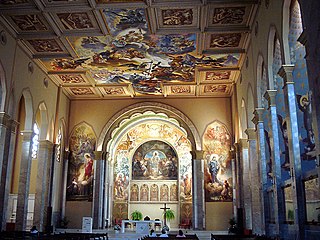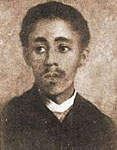 W
WLucílio de Albuquerque was a Brazilian painter, designer and art professor.
 W
WFrancisco Pedro do Amaral was a Brazilian painter, designer, scenographer and gilder.
 W
WManuel da Costa Ataíde, better known as Mestre Ataíde, was a Brazilian painter, sculptor, gilder and teacher.
 W
WAtiliano Felix Bernardelli was a Brazilian Mexican painter and musician. He spent most of his life in Mexico teaching art. Gerardo Murillo and Roberto Montenegro were among his pupils.
 W
WModesto Brocos y Gómez was a Spanish painter, and engraver, naturalized Brazilian citizen.
 W
WPedro Paulo Bruno was a Brazilian painter, singer, poet, and landscaper of Italian origin. His best known work is the 1918 painting A Pátria (Fatherland), which depicts the Brazilian flag being embroidered by a family.
 W
WAthos Bulcão was a Brazilian painter and sculptor. He was born in Rio de Janeiro.
 W
WBenedito Calixto de Jesus was a Brazilian painter. His works usually depicted figures from Brazil and Brazilian culture, including a famous portrait of the bandeirante Domingos Jorge Velho in 1923, and scenes from the coastline of São Paulo. Unlike many artists of the time, Calixto's patron was an individual other than the state, who were "the most dependable source of patronage."
 W
WIberê Bassani Camargo was a Brazilian painter, one of the greatest expressionist artists from his country.
 W
WHipólito Boaventura Caron (1862–1892) was a Brazilian painter and designer associated with the "Grupo Grimm".
 W
WGiovanni Battista Felice Castagneto, or João Batista Castagneto, was an Italo-Brazilian landscape and seascape painter.
 W
WArthur Timótheo da Costa was an Afro-Brazilian painter and designer.
 W
WJoão Zeferino da Costa was a Brazilian painter and designer.
 W
WAgostinho José da Mota was a Brazilian painter and teacher.
 W
WManuel Dias de Oliveira was a Brazilian painter, decorator and art professor.
 W
WRicardo do Pilar (1635–1700) was a Brazilian monk and painter.
 W
WThomas Georg Driendl was a German-born Brazilian painter, architect, and art restorer. He specialized in landscapes, portraits and religious themes.
 W
WJoão Fahrion was a Brazilian painter, engraver, draughtsman and illustrator. He was born and died in Porto Alegre.
 W
WGessiron Alves de Franco, known as Siron Franco Brazilian painter and sculptor, Siron Franco was born in Goiás Velho, GO, on July 26, 1947. Siron Franco spent his childhood and adolescence in Goiânia, taking his first painting lessons under the guidance of the artists DJ Oliveira and Cleber Gouveia. He started making a living at the age of 13, painting and selling portraits of the cities´ bourgeoise. In 1965, he focused on drawings, following the unreal and grotesque sketches he had in mind. In 1968 he won the National Biennal of Bahia. Between 1969 and 1971, Siron lived in São Paulo, frequented the studios of Bernardo Cid and Walter Lewy in São Paulo and was one of the members of the group that participated in the exhibition Surrealism and Fantastic Art at Seta Gallery. In 1973, Siron Franco won the prestigious Salao Global da Primavera in Rio de Janeiro. Afterwards he spent a year living in Mexico City. After winning the International prize of São Paulo´s Biennal Exhibition in 1975, Siron toured Europe between 1976 and 1978 living mainly in Toledo and Madrid in Spain. In 1982, his Exhibition at Bonino Gallery was considered the best of the year in Brazil and Siron received the distinguished title of the best Brazilian Painter of 1982 by APCA, São Paulo's Painters & Critics Association.
 W
WDomingo García y Vásquez was a Spanish-born Brazilian landscape painter.
 W
WJoão Ghelfi was a Brazilian painter.
 W
WClóvis Graciano was a Brazilian artist who worked with painting, drawing, scenography, costume design, engraving and illustration.
 W
WAldo Locatelli was an Italian painter. His most important works are the frescos and panels in churches and public buildings of Rio Grande do Sul.
 W
WAmadeo Luciano Lorenzato, better known as Lorenzato was a Brazilian modernist artist. His painting portrays landscape and everday life in tropical savanna during Minas Gerais urbanization. Lorenzato's paintings also have a very characteristic pattern made by the use of vivid colors mixed with an adapted comb that left shades and texture at the canvases.
 W
WManabu Mabe (マナブ間部) was a Japanese-Brazilian painter. Mabe worked as a vendor of hand-painted ties in São Paulo before becoming a famous artist.
 W
WAldir Mendes de Sousa (1941–2007) was a Brazilian painter and physician.
 W
WSérgio Milliet da Costa e Silva, generally known as Sérgio Milliet was a Brazilian writer, painter, poet, essayist, literary and art critic, and sociologist.
 W
WAntônio Firmino Monteiro was an Afro-Brazilian painter.
 W
WJoao Feliciano, Sr. (NicSon) is a contemporary Brazilian painter mostly known for his particular skills in palette knife painting. Also, one of the few autodidact impressionists alive whose art has reached commercial and critic success in Brazil.
 W
WKarl Ernst Papf, or Ernesto Papf was a German-born Brazilian photographer, painter and designer.
 W
WAntônio Diogo da Silva Parreiras was a Brazilian painter, designer and illustrator.
 W
WAntônio Rafael Pinto Bandeira (1863-1896) was an Afro-Brazilian painter and art professor.
 W
WManuel Lopes Rodrigues was a Brazilian Realist painter. Born in the city of Salvador, in the State of Bahia, he was initially homeschooled by his father, João Francisco Lopes Rodrigues, later entering at the Liceu de Artes e Ofícios, being taught by Miguel Navarro Cañizares.
 W
WSimplício Rodrigues de Sá was a Portuguese-born painter and art professor who spent most of his career in Brazil.
 W
WOsmar Santos is a former painter and journalist from Brazil. He was a very successful radio and television sports commentator in the 1980s and early 1990s, known for his outstanding verbal fluency and for his numerous catchphrases, which still punctuate Brazilian football culture. Throughout his career, Osmar Santos worked alongside major sportscasters and media personalities, such as Galvão Bueno, Fausto Silva and João Saldanha. He also worked as TV host in a number of shows. Osmar Santos publicly supported Diretas Já, a political movement for direct suffrage in Brazilian presidential politics.
 W
WJorge Selarón was a Chilean-born Brazilian painter and ceramist. He is perhaps best known for his work on the Escadaria Selarón, a world-famous set of ceramic tile-covered stairs located in the Lapa and Santa Teresa neighborhoods of Rio de Janeiro, Brazil.
 W
WEstêvão Roberto da Silva was an Afro-Brazilian painter and art teacher.
 W
WFélix Émile Taunay, Baron of Taunay, was a French Brazilian painter, and drawing and Greek teacher. He was the father of famous writer and politician Alfredo d'Escragnolle Taunay, the Viscount of Taunay.
 W
WEmmanuel Hector Zamor was a Brazilian-born painter who lived in France. He specialized in landscapes and still lifes in the style of the Barbizon school.
 W
WWilly Alfredo Zumblick was a Brazilian painter born in Tubarão, Santa Catarina state. His art expose historical facts, specially from his hometown.